In the rollercoaster of life, tires are a bit like the seatbelts – unsung heroes keeping us safe. They go round and round, day in and day out, silently enduring the pressure of both road and load. However, just like any fine piece of technology, they speak a language, their own code, if you will. And once we understand this language, our journey becomes a whole lot smoother.
So, buckle up, because we’re about to decipher the mysterious numbers and letters on our tire’s sidewalls. In this case, it’s the enigmatic “108v, 108h, 108w, 108t & 108y”.
What do 108t, 108s, 108q, 108h, 108r, 108v, 108w mean on a tire?
Before we get to the punchline, let’s serve up some context. The “108” you see is the load index of the tire, which simply refers to the maximum load the tire can carry at the maximum speed indicated by its speed symbol (the letter that follows the 108). Now, let’s throw in the characters – those delightful T, S, Q, H, R, V, W that tag along after the 108. These are speed ratings, representing the maximum speed for which the tire is rated.
| Load Index & Speed Symbol | Speed Rating | Maximum Speed (mph) |
|---|---|---|
| 108T | Touring speed | 118 mph |
| 108S | Standard speed | 112 mph |
| 108Q | Winter vehicle speed | 99 mph |
| 108H | High speed | 130 mph |
| 108R | Light truck speed | 106 mph |
| 108V | Very high speed | 149 mph |
| 108W | Ultra high speed | 168 mph |
What does 108T mean on a tire?
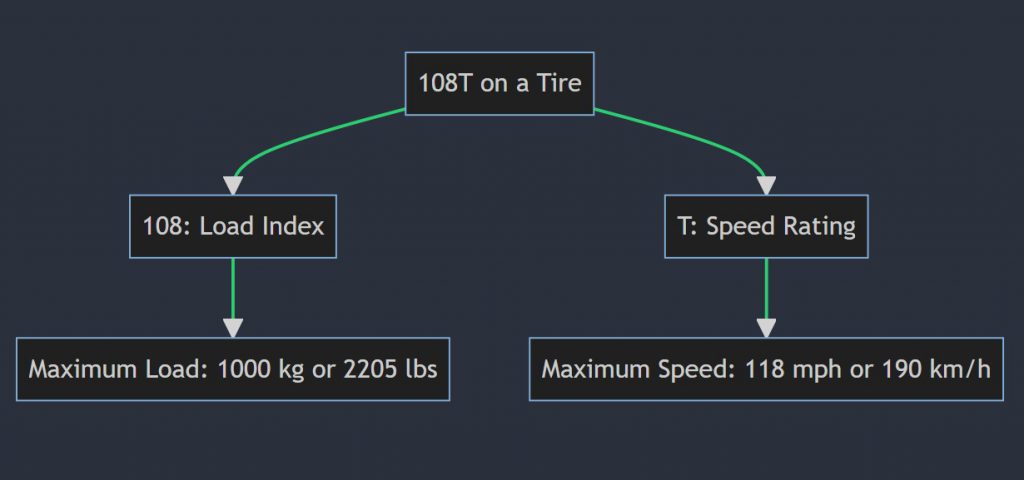
On a more detailed note, a tire with the marking “108T” indicates that the tire has a load index of 108 and a speed rating of T.
- Load Index 108: This value is a numerical code associated with the maximum load a tire can carry. For instance, a load index of 108 means the tire can support a maximum load of 1000 kg or 2205 lbs per tire. This doesn’t mean you can pile up a ton of bricks on your sedan and expect a smooth ride. Instead, it suggests that the combined weight of your vehicle, passengers, and additional load should ideally be within the total load capacity of your four tires.
- Speed Rating T: The T signifies that the tire can sustain that maximum load at a speed of up to 190 km/h or 118 mph. Keep in mind, this isn’t a suggestion to push your accelerator pedal to the metal but a safety guideline to ensure optimal tire performance and longevity.
What does 108S mean on a tire?
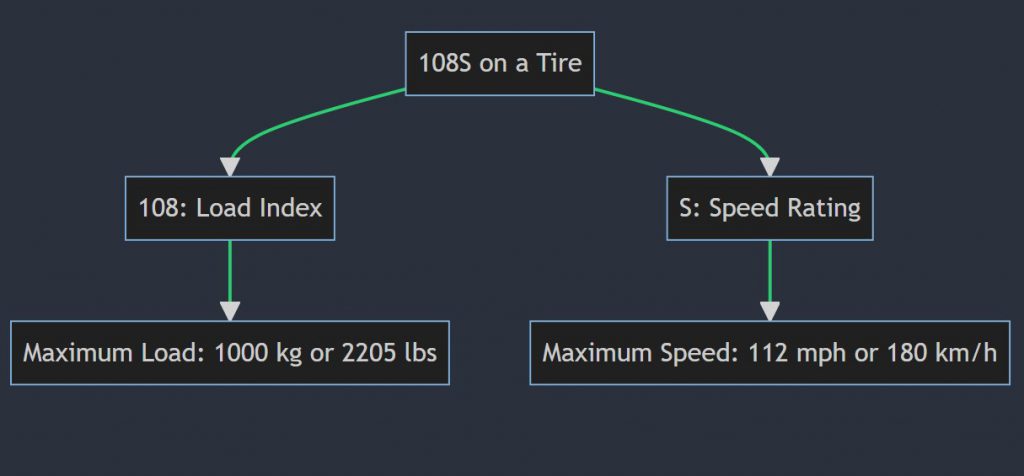
Let’s explore the intriguing “108S” on a tire, shall we?
- Load Index 108: Same as with 108T, this tells us that the tire can bear a maximum load of 1000 kg or 2205 lbs per tire.
- Speed Rating S: The S here means that your trusty tire can maintain that maximum load at a speed of up to 180 km/h or 112 mph. Again, this isn’t an invitation to audition for the next “Fast and Furious” franchise, but a safety standard to ensure your tires serve you well and long.
What does 108Q mean on a tire?
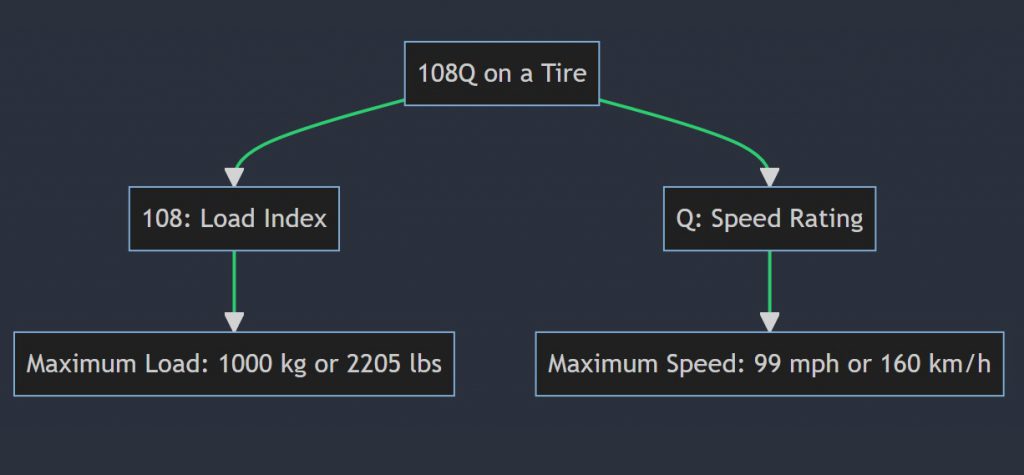
Your tire’s sidewall code is a bit like your favorite song’s lyrics – it’s cryptic, maybe a bit confusing at first, but once you understand it, it starts to make a whole lot of sense. So, let’s hit the high notes with 108Q.
- Load Index 108: Just like a talented drummer keeping the beat, the load index keeps your vehicle balanced. A load index of 108 can sustain a maximum load of 1000 kg or 2205 lbs per tire. So, even if you’ve packed enough for a cross-country road trip, as long as your total load is within the capacity, your tires won’t be complaining – they’ll just keep rolling!
- Speed Rating Q: This one is for all those winter adventurers out there! A speed rating of Q indicates that the tire can maintain that maximum load at a top speed of 160 km/h or 99 mph, usually in wintery conditions. However, remember this isn’t a challenge to see how fast you can blaze down a snow-covered highway. It’s a friendly safety guideline, a warm cup of cocoa from your tire saying, “Let’s keep it chill and safe on these icy roads.”
The 108Q on a tire can often be seen on winter tires, playing the role of the unsung hero on icy and snowy roads. So, next time you’re enjoying the serene beauty of a winter’s drive, know that it’s your 108Q tires beneath, giving you the confidence to drive on.
What does 108H mean on a tire?
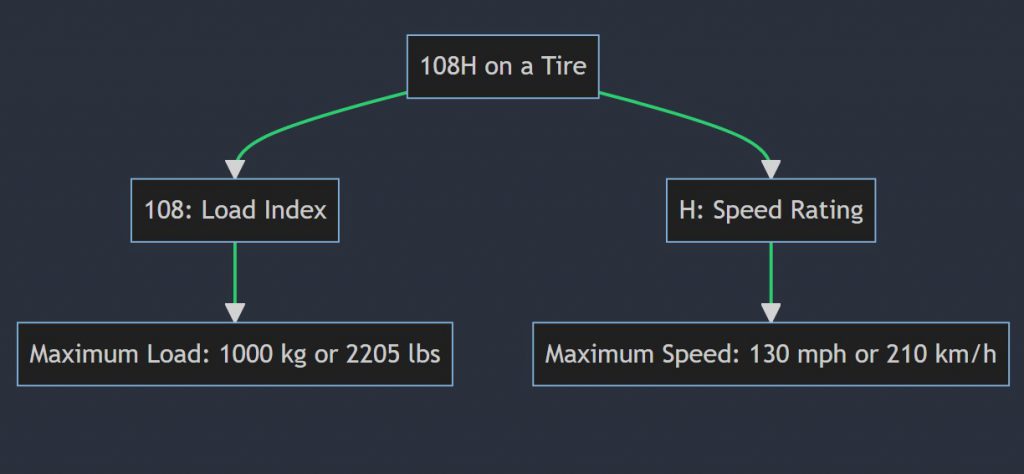
Ah, the good ol’ 108H – a tire that speaks to those with a need for a little extra speed. Let’s unwrap what this alphanumeric nugget means:
- Load Index 108: We’re now familiar with our trusty load index. With a value of 108, it means this tire can carry a maximum load of 1000 kg or 2205 lbs per tire. It’s like the tire’s saying, “Load me up, I got this!”
- Speed Rating H: The H in this equation stands for high-speed, rating the tire to carry its maximum load up to 210 km/h or 130 mph. Don’t interpret this as a green flag to break speed limits though, it’s simply a measure of the tire’s capability in ideal conditions.
What does 108R mean on a tire?
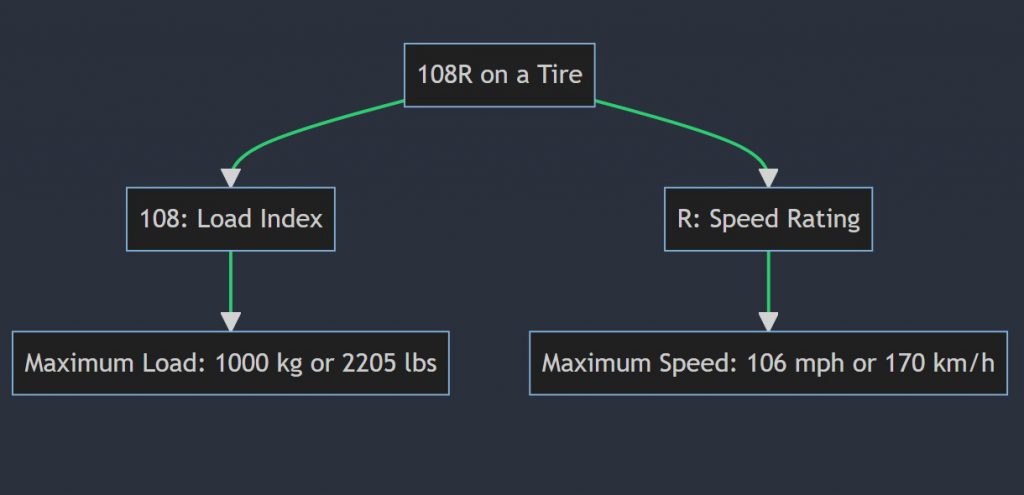
If tires were rockstars, 108R would be the drummer, steadily carrying the beat while cruising unnoticed. But today, it’s the drummer’s solo moment. Let’s delve into the rock ‘n’ roll of 108R!
- Load Index 108: By now, you’re probably dreaming about load indexes. A 108 load index means the tire can carry a maximum load of 1000 kg or 2205 lbs per tire. It’s like the tire is flexing its muscles and saying, “Hey, I can handle this!”
- Speed Rating R: Now, R doesn’t stand for rockstar in tire lingo, but it’s equally cool. Tires with an R rating are often used in light trucks, SUVs, and some off-road vehicles. The R implies that the tire can handle its maximum load at speeds of around 170 km/h or 106 mph.
So next time you’re hauling your band’s equipment in your light truck or SUV, take a moment to appreciate the 108R tires beneath. They are indeed the rockstars, doing the heavy lifting and keeping you steady on the road.
What does 108V mean on a tire?
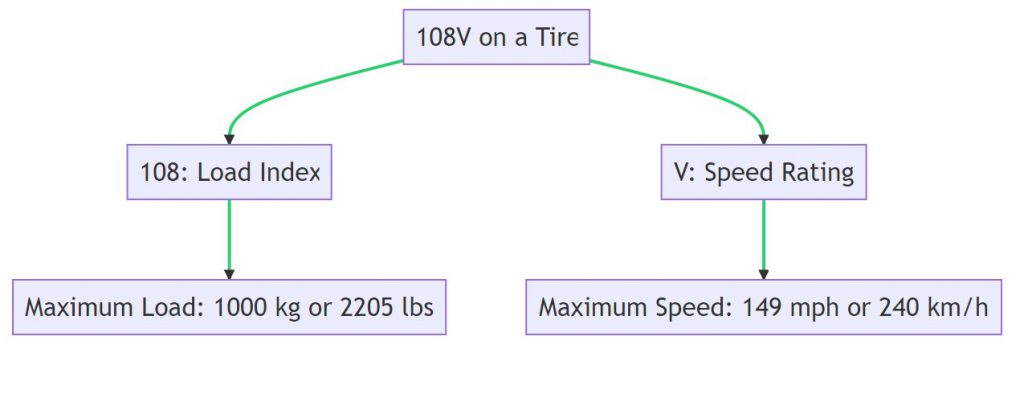
The 108V on a tire is like that spine-tingling, adrenaline-pumping guitar riff in your favorite song. It’s all about speed and performance while maintaining a delicate balance. So, let’s tune in to the melody of 108V!
- Load Index 108: Like the steady bass line in a song, the load index remains consistent. A load index of 108 translates to a maximum load of 1000 kg or 2205 lbs per tire.
- Speed Rating V: The V here is all about velocity. A speed rating of V means the tire is tested to perform safely up to speeds of 240 km/h or 149 mph. It’s like your tire whispering, “Fast and steady, that’s how I roll!”
The 108V is commonly seen on performance sedans, sports cars, and certain SUVs. It’s a testament to your vehicle’s ability to perform at higher speeds while ensuring safety. Remember, it’s not a challenge to emulate a race car driver; it’s a mark of your tire’s potential.
What does 108W mean on a tire?
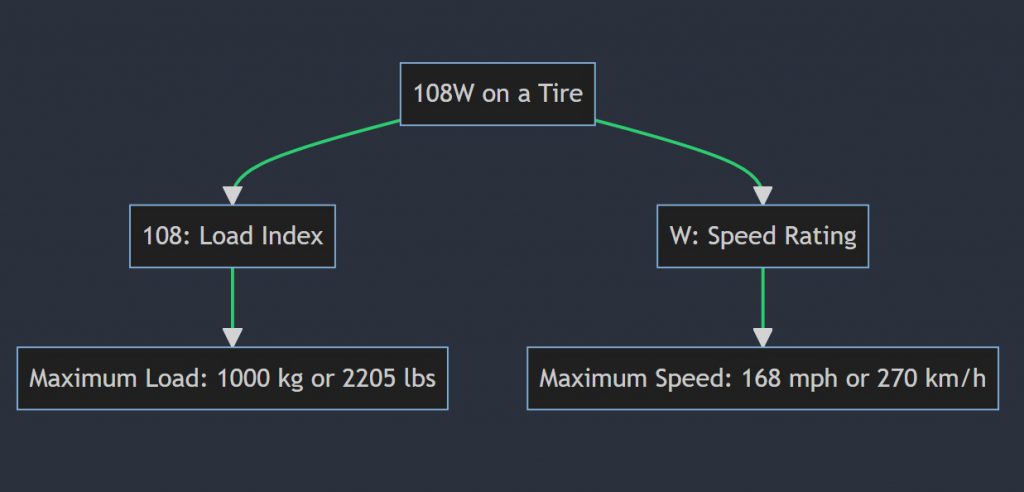
If tires were a band, the 108W would undoubtedly be the lead singer. Its charm lies in its balance of strength and speed, just like a vocalist harmonizing power and melody. But before we go off on a rock ‘n’ roll tangent, let’s get back to the tire talk.
- Load Index 108: By this point, you’ve probably become best friends with our dependable load index of 108. This indicates a maximum load capacity of 1000 kg or 2205 lbs per tire.
- Speed Rating W: When you see a W on your tire, you should think “Wow!” This speed rating is one of the highest in the line-up. It signifies that your tire can handle its maximum load at speeds up to 270 km/h or 168 mph. No, this doesn’t mean you should start envisioning yourself in a Formula 1 race. It’s simply a testament to the tire’s design and capabilities.
Tires with a 108W rating are often found on high-performance vehicles, sports cars, and luxury sedans. So, next time you glance at your tire and see 108W, give a little nod of respect to its exceptional balance of strength and speed, its capacity to handle heavy loads at high speeds, while always ensuring your safety and comfort.
FAQs
In this segment, we’ll address some common queries you might have about the different tire codes, like the battle of the bands among 108T, 108H, 108S, 110T, 104T, and 103T. Let’s get rolling!
108T vs 108H
Ah, the classic 108T vs 108H conundrum. Both have the same load index, meaning they can carry the same weight. The key difference is in the speed rating. 108T tires are designed for a maximum speed of 118 mph, while 108H tires can safely reach speeds of up to 130 mph. Think of 108H as the older sibling who’s allowed to stay out a little later!
108T vs 110T
Here, the difference lies in the load index. While a 108T tire can handle up to 1000 kg, the 110T tire can carry a slightly heavier load of up to 1060 kg. So, if you’re planning a road trip with a lot of luggage, you might want to consider 110T. But don’t forget to check your vehicle’s recommended load index!
104T vs 108T
Again, the difference here lies in the load index. 104T can handle a maximum weight of 900 kg, while 108T ups the ante to 1000 kg. Essentially, 108T is like 104T after a few weeks of weight training!
103T vs 108T
This difference is all about the load index. A 103T tire can carry up to 875 kg, while a 108T can handle 1000 kg. Imagine the 108T saying to 103T, “Don’t worry, I got that extra luggage covered!”
108S vs 108T tires
This match-up is about the speed rating. 108S tires can handle speeds up to 112 mph, while 108T can go up to 118 mph. It’s like comparing a cheetah and a gazelle – both are fast, but one just has that little extra speed!
108S vs 105S
In the 108S vs 105S face-off, the difference is in the load index. A 108S tire can carry up to 1000 kg, while a 105S tire can handle 925 kg. It’s like comparing a heavyweight boxer to a middleweight – both are strong, but one can handle a bit more!
Remember, all these comparisons come with a caveat: always refer to your vehicle’s user manual or consult with a tire professional before choosing a tire. The goal is to ensure optimal performance and safety on the road. After all, driving is no joking matter – well, unless your tires start cracking jokes!
Recap And Summary
Well, there you have it, folks! A comprehensive exploration of the mysterious world of tire codes. We’ve taken a deep dive into understanding the meaning behind 108T, 108S, 108Q, 108H, 108R, 108V, and 108W on a tire.
Through our journey, we’ve discovered that the 108 is the load index, telling us about the maximum load capacity of the tire. We’ve also learned about the speed ratings, those sneaky letters that followed our 108, giving us insights into the maximum speeds the tires can handle safely.
From 108T’s modest speed to 108S’s slightly faster pace, from the winter warrior 108Q to the highway cruiser 108H, and from the rockstar 108R to the speedy champs 108V and 108W, each tire code tells a different story, perfectly tuned to different vehicles and driving conditions.
Alternative Tire Size Codes of Similar Specifications

AR Jeet has been a tire mechanic for over 2years. He has worked on all types of vehicles, from cars and trucks to RVs and ATVs and motorcycles. He has seen it all when it comes to tires, and he knows how to fix them.
AR Jeet is a tire expert, and he is passionate about his work. He loves to help people keep their vehicles running smoothly, and he is always happy to answer any questions that people have about their tires.
If you need help with your tires, or if you just want to learn more about them, then AR Jeet is the man to talk to. He will be happy to help you out, and he will make sure that you get the best possible solution.
He has a blog [Tirespick.com] where he writes about all things tire-related, and he is always happy to help people with their tire needs. Know more about AR Jeet.
